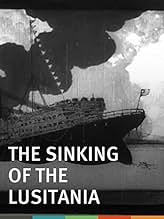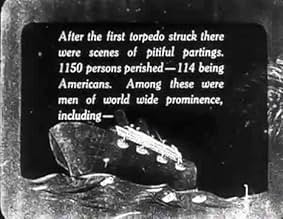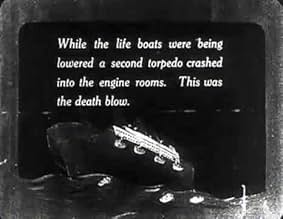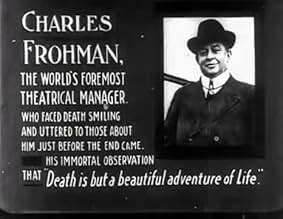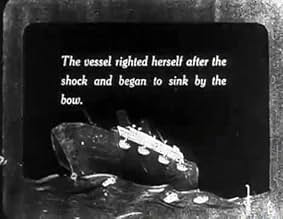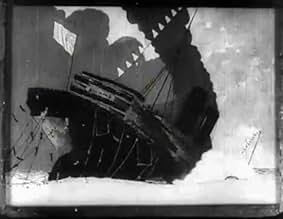CALIFICACIÓN DE IMDb
6.8/10
1.3 k
TU CALIFICACIÓN
Agrega una trama en tu idiomaAn animated dramatization of the notorious World War I German torpedoing of the ocean liner, Lusitania.An animated dramatization of the notorious World War I German torpedoing of the ocean liner, Lusitania.An animated dramatization of the notorious World War I German torpedoing of the ocean liner, Lusitania.
- Dirección
- Guionista
- Elenco
- Premios
- 1 premio ganado en total
- Dirección
- Guionista
- Todo el elenco y el equipo
- Producción, taquilla y más en IMDbPro
Opiniones destacadas
From Winsor McCay, the revolutionary animation pioneer and director of the charming classic "Gertie the Dinosaur" comes a much darker animated tale. This film recounts the tragic striking and sinking of the Lusitania which took away over 1000 lives. This film is highly respectful in execution, and it certainly isn't what you would expect from McCay, who normally crafted extremely funny and enjoyable animations rather than heartbreaking dramas. But, although its execution is much different than any other silent drama on the subject could be, it is highly effective and powerful, not to mention well made! The animation is wonderfully done, and doesn't look too "cartoony" for the depressing subject matter. McCay creates haunting and slightly propagandic images with this invention, images that wouldn't have been successfully captured on a 1918 movie set.
Animation pioneer Winsor McCay applies all his considerable skills in this feature, creating a detailed and memorable account of the sinking of the Lusitania. The technique still looks quite good, and it really brings the events to life. It must have been quite effective in its time.
There are lots of details that not only are carefully rendered, but that also are used effectively to add to the overall effect. It both communicates the factual details and brings out the horrors of the situation as well as any short feature could do. The events seem to be depicted with great care and accuracy, and only the strongly-worded commentary on a few of title cards reveals the creator's viewpoint. (It doesn't detract from the fine quality of this movie, but it's always unfortunate when entire nations of people are condemned for the barbarous or irresponsible actions of some of their leaders. It's understandable, of course, but unfortunate.)
The Lusitania sinking was one of the most notorious events in a century that saw more than enough of them. This carefully crafted movie does its job in preserving both what happened and the response to it.
There are lots of details that not only are carefully rendered, but that also are used effectively to add to the overall effect. It both communicates the factual details and brings out the horrors of the situation as well as any short feature could do. The events seem to be depicted with great care and accuracy, and only the strongly-worded commentary on a few of title cards reveals the creator's viewpoint. (It doesn't detract from the fine quality of this movie, but it's always unfortunate when entire nations of people are condemned for the barbarous or irresponsible actions of some of their leaders. It's understandable, of course, but unfortunate.)
The Lusitania sinking was one of the most notorious events in a century that saw more than enough of them. This carefully crafted movie does its job in preserving both what happened and the response to it.
America had entered the war by the time Winsor McCay released this film. The sinking of the Lusitania, which carried munitions as well, swayed American sentiment, but not until Germany retracted its guarantee of not repeating the tragedy, among other issues of course, did the US ally. McCay's masterpiece was surely as worthy propaganda as posters, as there was still fight to last a few more months.
By 1918, the celluloid animation process had been invented. John Fitzsimmons and Apthorp Adams providing such as the waves with less monotony to the task, and McCay is supposed still to have created some 25,000 drawings for the production. As he had done with previous shorts, McCay produced a live-action introduction promoting his dedication and hard work. His last film, "Gertie the Dinosaur", drawn on rice paper before the advent of cel animation, was the most accomplished work of animation to date. Yet, with a cliché not to be used lightly, "The Sinking of the Lusitania" was ahead of its time--years before the assembly lines of animation studios would attain such splendor. Where Gertie was a likable, coy cartoon--one of the first personated characters in animation, this short is a moving tragedy transcending to likeness re live-action.
It likens a subjective docudrama styled as a propaganda newsreel. It contains shots impossible to have covered, impossible to have recreated in a live-action film as of then, although probably thought impossible to create in animation until McCay did it. The framing and positioning is apt, the detail meticulous. There was little need for me to screen this film again before writing this comment; images of the ocean liner steaming past the Statue of Liberty, floral smoke arising from the torpedo hits, rhapsodic falling bodies, bobbing heads and the isolated sinking in the final shot to punctuate the event, I'll always remember.
By 1918, the celluloid animation process had been invented. John Fitzsimmons and Apthorp Adams providing such as the waves with less monotony to the task, and McCay is supposed still to have created some 25,000 drawings for the production. As he had done with previous shorts, McCay produced a live-action introduction promoting his dedication and hard work. His last film, "Gertie the Dinosaur", drawn on rice paper before the advent of cel animation, was the most accomplished work of animation to date. Yet, with a cliché not to be used lightly, "The Sinking of the Lusitania" was ahead of its time--years before the assembly lines of animation studios would attain such splendor. Where Gertie was a likable, coy cartoon--one of the first personated characters in animation, this short is a moving tragedy transcending to likeness re live-action.
It likens a subjective docudrama styled as a propaganda newsreel. It contains shots impossible to have covered, impossible to have recreated in a live-action film as of then, although probably thought impossible to create in animation until McCay did it. The framing and positioning is apt, the detail meticulous. There was little need for me to screen this film again before writing this comment; images of the ocean liner steaming past the Statue of Liberty, floral smoke arising from the torpedo hits, rhapsodic falling bodies, bobbing heads and the isolated sinking in the final shot to punctuate the event, I'll always remember.
The Sinking of the Lusitania (1918)
*** (out of 4)
This WWI propaganda piece is from Winsor McCay, the famed animator who decided to use his skills and so something quite different. This film documents the German attack on the Lusitania ship, which was carrying 2000 people when it was hit by a couple torpedoes and sank fifteen-minutes later. The film clocks in at twelve-minutes and the animation is used to show what happened and then we're given actual footage talking about how evil Germany is and we also have a brief tribute to some of the men who were lost. This is a fairly interesting film on many levels but the biggest is because of all the fire and passion that McCay brings to the material. There's no doubt that this was a very personal film to him and he clearly makes his feelings known by attacking Germany on pretty much every level. There's no question that the gloves are off as the title cards are quite damning to the actions that were done that day. The animation of the boat sinking is quite simple on one hand but I'd argue there are still some very striking moments here. I think the greatest are the shots of the ship and the smoke coming from it. The long, complete shots of the ship are quite striking in their animated form and just watch the way that the smoke comes off of it. The previously mentioned tribute shows some of the famous people that died on the ship, which was somewhat questionable and especially since none of the other victims are even mentioned and no tribute is given to them. With that said, this is still very much worth seeing just for the passion that it displays.
*** (out of 4)
This WWI propaganda piece is from Winsor McCay, the famed animator who decided to use his skills and so something quite different. This film documents the German attack on the Lusitania ship, which was carrying 2000 people when it was hit by a couple torpedoes and sank fifteen-minutes later. The film clocks in at twelve-minutes and the animation is used to show what happened and then we're given actual footage talking about how evil Germany is and we also have a brief tribute to some of the men who were lost. This is a fairly interesting film on many levels but the biggest is because of all the fire and passion that McCay brings to the material. There's no doubt that this was a very personal film to him and he clearly makes his feelings known by attacking Germany on pretty much every level. There's no question that the gloves are off as the title cards are quite damning to the actions that were done that day. The animation of the boat sinking is quite simple on one hand but I'd argue there are still some very striking moments here. I think the greatest are the shots of the ship and the smoke coming from it. The long, complete shots of the ship are quite striking in their animated form and just watch the way that the smoke comes off of it. The previously mentioned tribute shows some of the famous people that died on the ship, which was somewhat questionable and especially since none of the other victims are even mentioned and no tribute is given to them. With that said, this is still very much worth seeing just for the passion that it displays.
McCay's animation is hypnotic and the realism is shocking. It's all on the same horizontal plane of action, but that makes it so strong and potent to look at, since the point of view doesn't change too much, except to show people falling off the boat. The intertitles don't help so much; they break up the flow of the images and even down to seeing the names and faces and bios on certain 'famous' people of the period (major figures I'm sure but still a distraction), and I wanted to get more Windsor McKay drawings. Showing his process was fascinating too, as the short begins with McKay getting his drawing-marching orders, and you see how he starts with the water, and then lays in everything else. The most shocking part comes with those little figures falling off the ship in droves, but each one has enough detail that they can be distinguished as human beings.
¿Sabías que…?
- TriviaAs First Lord of the Admiralty Winston Churchill allowed civilian ships to transport war munitions for the Western Front. He prevented German U-Boats from searching the ships by illegally arming merchant ships, introducing Q-ships with concealed deck guns, and by ordering merchant captains to evade and submarines that surfaced.
- ErroresThe German submarine fired only one torpedo, not two. The second explosion originated from within the ship near where the torpedo hit. The cause still remains uncertain. It has been widely speculated that the second explosion was caused by war munitions the ship was illegally transporting for the Western Front.
- ConexionesEdited into Los comienzos de la animación (1995)
Selecciones populares
Inicia sesión para calificar y agrega a la lista de videos para obtener recomendaciones personalizadas
Detalles
- Fecha de lanzamiento
- País de origen
- Idiomas
- También se conoce como
- The Sinking of the 'Lusitania', an amazing moving pen picture by Winsor McCay.
- Productora
- Ver más créditos de la compañía en IMDbPro
- Tiempo de ejecución12 minutos
- Color
- Mezcla de sonido
- Relación de aspecto
- 1.33 : 1
Contribuir a esta página
Sugiere una edición o agrega el contenido que falta

Principales brechas de datos
By what name was The Sinking of the 'Lusitania' (1918) officially released in Canada in English?
Responda
